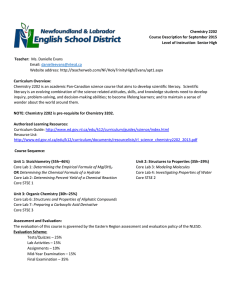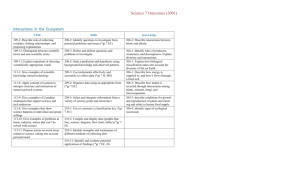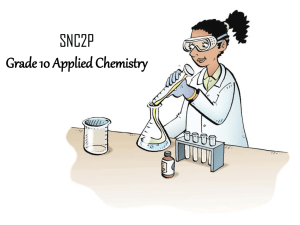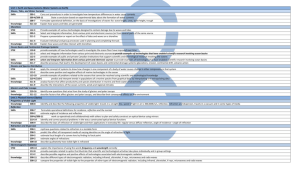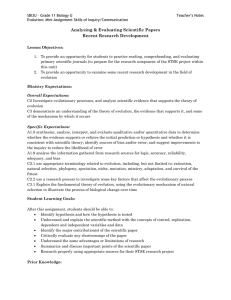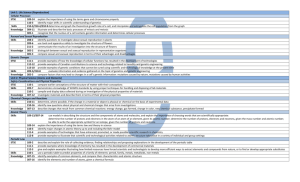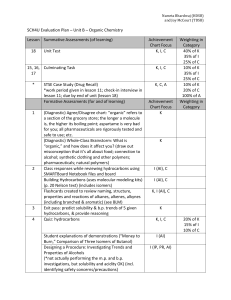Final Paper (Erminia Pedretti)
advertisement
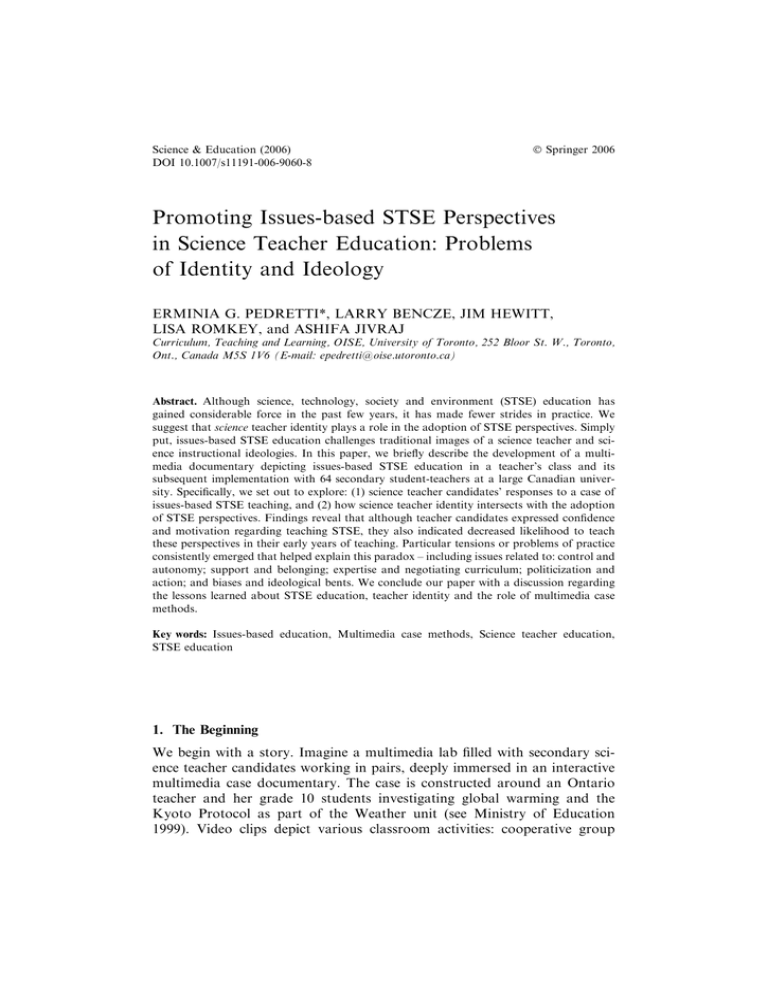
Science & Education (2006) DOI 10.1007/s11191-006-9060-8 Ó Springer 2006 Promoting Issues-based STSE Perspectives in Science Teacher Education: Problems of Identity and Ideology ERMINIA G. PEDRETTI*, LARRY BENCZE, JIM HEWITT, LISA ROMKEY, and ASHIFA JIVRAJ Curriculum, Teaching and Learning, OISE, University of Toronto, 252 Bloor St. W., Toronto, Ont., Canada M5S 1V6 (E-mail: epedretti@oise.utoronto.ca) Abstract. Although science, technology, society and environment (STSE) education has gained considerable force in the past few years, it has made fewer strides in practice. We suggest that science teacher identity plays a role in the adoption of STSE perspectives. Simply put, issues-based STSE education challenges traditional images of a science teacher and science instructional ideologies. In this paper, we briefly describe the development of a multimedia documentary depicting issues-based STSE education in a teacher’s class and its subsequent implementation with 64 secondary student-teachers at a large Canadian university. Specifically, we set out to explore: (1) science teacher candidates’ responses to a case of issues-based STSE teaching, and (2) how science teacher identity intersects with the adoption of STSE perspectives. Findings reveal that although teacher candidates expressed confidence and motivation regarding teaching STSE, they also indicated decreased likelihood to teach these perspectives in their early years of teaching. Particular tensions or problems of practice consistently emerged that helped explain this paradox – including issues related to: control and autonomy; support and belonging; expertise and negotiating curriculum; politicization and action; and biases and ideological bents. We conclude our paper with a discussion regarding the lessons learned about STSE education, teacher identity and the role of multimedia case methods. Key words: Issues-based education, Multimedia case methods, Science teacher education, STSE education 1. The Beginning We begin with a story. Imagine a multimedia lab filled with secondary science teacher candidates working in pairs, deeply immersed in an interactive multimedia case documentary. The case is constructed around an Ontario teacher and her grade 10 students investigating global warming and the Kyoto Protocol as part of the Weather unit (see Ministry of Education 1999). Video clips depict various classroom activities: cooperative group ERMINIA G. PEDRETTI ET AL. learning, teacher-centred instruction, a culminating town hall debate, and teacher and student interviews. As researchers and teacher educators, we delighted at the level of discourse and excitement generated by this science, technology, society and environment (STSE) multimedia case. We deliberately designed this interactive case in an effort to illustrate issues-based STSE in theory and practice. We focused on the use of issues-based material (see Pedretti 1996; Zeidler et al. 2005) as one way of addressing STSE education. However, as time progressed, and we revisited data, we were struck by other emergent issues. For example, some teacher candidates, while engaged in the activity, seemed to bristle at the suggestion that this material should be part of the curriculum. Others, although they theoretically endorsed the approach, seemed perturbed and genuinely worried about its implementation. In other words, we felt some resistance to STSE education, which, as the literature suggests, is not entirely surprising (see for example, Hughes 2000; Pedretti 2003). This paradoxical situation – being able to engage students in a lively and stimulating teacher education activity about the theoretical merits of STSE education, while on the other hand, being less than enthusiastic about the practicalities of implementation – raised a series of questions for us. We began to ask how teacher candidates’ sense of self, professional identity, and ensuing survival instincts in the first few years of practice might affect their views of STSE education. Is STSE education connected to their understandings of science as a content-based subject? How does their developing professional identity as a science teacher encourage or discourage adoption of STSE perspectives? Or does STSE require such a complex set of content and pedagogical content knowledge that teachers shy away from it? This paper represents our preliminary attempt to unpack these issues with a group of 64 pre-service secondary science teachers. We embed our inquiry in the notion of teacher identity and the distinct challenges of STSE education. Specifically, we set out to explore: (1) science teacher candidates’ responses to a case of issues-based STSE teaching, and (2) how science teacher identity intersects with the adoption of STSE perspectives. 2. Theoretical Considerations We draw on two strands of literature to inform our study: (1) teacher identity and STSE education and (2) the use of multimedia case methods in pre-service teacher education. Each of these is discussed below. 2.1. TEACHER IDENTITY AND STSE EDUCATION The literature base on teacher identity is broad (see for example, Elbaz 1983; Goodson 1992; Siskin 1994; Beijaard et al. 2000). A cursory review PROMOTING ISSUES-BASED STSE PERSPECTIVES of the literature suggests that teachers’ professional lives form within multiple embedded contexts. A teachers’ sense of self develops at the intersections of life histories, experiences, and socialization into a professional community. The sense of self also comes from what a person believes, values, and what a person wants to become (Talbert 1995; Helms 1998). In spite of the extensive literature on teacher identity, there is paucity of literature that explores science teachers’ professional identity (see Helms 1998; Varelas et al. 2005). Helms (1998) argues that while much has been done, for example, on teachers’ understandings of the nature of science (Brickhouse 1990; Lederman 1992), the ways in which science teachers obtain a sense of personal or professional identity from their subject matter are not sufficiently considered. Affiliation and loyalty to subject matter, like science, is critical to science teachers’ formation of professional identity, and to this study. We acknowledge that while affiliation to subject matter helps foster a science teachers’ sense of belonging to a community – ‘‘a consciousness of kind’’ (Little 1993) – it ironically creates barriers to adopting an issues-based STSE approach. Simply put, issues-based STSE education challenges traditional images of a science teacher and science instructional ideologies (see for example, Helms 1998; Shumba 1999; Pedretti 2003). Traditionally, for example, the focus in science education has been on teaching and learning disciplinary knowledge (Roth & Dèsautels 2002). Conventional science teaching includes ‘‘dealing with established and secure knowledge, while contested knowledge, multiple solutions, controversy and ethics have been excluded’’ (Hodson 2003, p. 664). Many teachers fear that extensive coverage of socioscientific issues devalues the curriculum, alienates traditional science students and jeopardizes their own status as gatekeepers of scientific knowledge (Hughes 2000). Typically, the teacher is in control, and students engage in closed ended replication or verification kinds of inquiry, with little room for creativity, imagination or open-endedness. Often science instructional strategies do not include town halls, debate or role-play (typical of STSE education). These latter activities are perceived as belonging to other domains – English or History for example. STSE1 (with its focus on decision-making, ethics, action, transformation and empowerment) is clearly not the dominant paradigm of science teaching. Its implementation creates, for many teachers, thorny problems of practice, and challenges science teachers’ professional identities. 2.2. MULTIMEDIA CASE METHODS IN TEACHER EDUCATION Teacher education programs can play a critical role in helping prospective teachers understand and teach about STSE education (Matthews 1998; Spector et al. 1998), and so address the theory/practice gap. Aware of the ERMINIA G. PEDRETTI ET AL. growing interest in the use of multimedia case methods for the purposes of teacher education (Koballa & Tippins 2000; Bencze et al. 2001, 2003; Hewitt et al. 2003; Brophy 2004; Wong 2006), we constructed an interactive video-based case method to illustrate (and study) the development and implementation of issues-based STSE instruction in a science classroom. Specifically, we designed a multimedia case depicting a grade 10 teacher and her students exploring the issue of global warming and the Kyoto Protocol. Through the use of this case method, we hoped to provide our pre-service students with a window into authentic, contextualized STSE teaching and learning. Video, with graphic and text-based support through multimedia technologies, can capture the complexity of classroom interactions enabling pre-service teachers to view ‘real’ teaching and learning strategies practised by the teacher (Cannings & Talley 2002). Shulman (1992) outlines five seminal uses for case studies in the preservice curriculum: to teach principles or concepts of a theoretical nature, provide precedents for practice, convey moral or ethical principles, teach strategies, disposition, and habits of mind, and provide visions or images of the possible. By employing multi-media case methods in teacher education programs we provide important scaffolds that potentially promote attitudinal change and self-efficacy (see for example, Koballa & Tippins 2003; Yoon et al. 2006), and demonstrate the possibilities for practice. 3. Case Method Context and Development STSE perspectives are an important part of Canada’s curriculum documents (see Council of Ministers of Education Canada 1997). In Ontario, for example, the Grades 9 and 10 provincial science curriculum document is explicit in its treatment of STSE education: The newer aspects of the science curriculum-especially those that focus on science, technology, society, and the environment (STSE)-call for students to deal with the impacts of science on society, and this requirement brings in issues that relate to human values. (Ministry of Education and Training 1999, p. 5) Although STSE has gained considerable force in the past few years, it has made fewer strides in practice. As pre-service educators, we constantly searched for effective ways of bringing STSE perspectives to the forefront, enhancing teachers’ self-efficacy (Bandura 1995), and equipping students to understand theory and practice of STSE education. Hence our use of a multimedia case to provide a ‘real-life’ example of STSE in practice. This STSE multimedia case is the fourth of a series that we have created during the past four years (see Bencze et al. 2001, 2003; Hewitt et al. 2003; Yoon et al. 2006). The case was constructed using six videotaped sessions of Anna’s classes. In total, we collected over 24 h of footage and PROMOTING ISSUES-BASED STSE PERSPECTIVES supporting materials – such as teacher lesson plan outlines, and assessment and evaluation tools. As a research team, we centred our discussions on how principles and practices of STSE education might be best represented to our pre-service students through this multimedia case. We decided to focus on: 1. Teacher challenges and strategies in planning for and implementing an issues-based STSE approach; 2. Knowledge and skills gained by students in an STSE curriculum emphases; and 3. Pedagogical differences between an issues-based approach and other approaches used in science teaching. Each member of the research team independently reviewed and coded classroom, teacher and student interview footage. Through extensive collaborative negotiations, we co-constructed a multimedia depiction of particular teaching and learning episodes for that unit. Six months later, we produced a 45-min interactive multimedia video that included teaching episodes throughout the weather unit, students engaged in cooperative learning activities, student interviews and commentaries, pre- and post-lesson teacher interviews, and the culminating activity – the town hall debate. Once the case was constructed, we collaboratively designed methods for enabling our pre-service students to interact with the case (i.e., the ‘case method’). The case method consisted of a series of questions and activities to be completed by pre-service students working in pairs, as they worked through the multimedia case. Our case method was intended to assist students in extracting meaning from the experience (Wallace 2001), and to generate dialogue about teaching and learning through as issues-based approach. As a final note, we hasten to add that our case method was used in tandem with other pre- and post-instructional strategies such as: required readings based on STSE education (Pedretti 1996; Solomon 1993) written responses to the readings, in-class discussions, examination of appropriate science curriculum documents, and post-discussions. 4. Methodology Our research primarily falls within the naturalistic paradigm, enabling themes and conclusions to emerge from the particular situations under study (Lincoln & Guba 2000). Through an inductive approach (Cresswell 1998) emergent key issues and recurrent patterns became the categories of focus. Consent was obtained from three pre-service secondary science methods classes at a large Canadian University. Two sections specialized in general science curriculum and instruction, while the third class specialized ERMINIA G. PEDRETTI ET AL. in biology. Each section included approximately 20–22 pre-service teachers and represented a range of experience, age, ethnic and cultural backgrounds, and knowledge of issues in science and technology education. All pre-service teachers held at least one previous degree in science or engineering. In total, 64 students participated in the study. In general, the case method, and corresponding research techniques involved: some activities prior to viewing the case, a 2-h class in which students teachers interacted with the case, and post-case activities. Our attention to multiple data collection techniques assisted in our triangulation of data. Data included: 1. Pre- and post-questionnaires (using Likert scales): Participating pre-service teachers completed a Likert-scale survey that focused on their attitudes and understandings of STSE education. This survey consisted of 10 statements (see discussion section below), that were piloted in the previous year. Surveys were completed at the beginning of the STSE unit in their curriculum and instruction course, and at the end (after the multimedia video portion of the case). The pre-service teachers ranked the statements as ‘‘strongly disagree,’’ ‘‘disagree,’’ ‘‘neutral’’ ‘‘agree’’ or ‘‘strongly agree.’’ 2. Open-ended surveys: Teacher candidates completed an open-ended survey, at the beginning of the unit, called ‘‘Where are you now with STSE education?’’ In particular, we asked four questions (based on Schwab’s (1969) ‘commonplaces’) regarding the nature of the learner, the nature of the teacher, the milieu, and resources. 3. Reflective writing: Pre-service teachers read two case study articles based on STSE education, and were asked to reflect on their attitudes and comfort level with STSE education. 4. Worksheets: While pre-service teachers viewed the multimedia case method they completed, in pairs, a worksheet. We focused, for the purposes of this paper, on their responses to questions regarding: (1) strategies Anna employed in implementing the STSE curriculum, (2) personal and professional challenges a teacher might encounter, when, for the first time, planning for implementing, assessing/evaluating an issuebased STSE approach, and (3) advantages and disadvantages about viewing the multimedia case. Responses to these questions informed our recommendations made in the final section of the paper. 5. Audio and video taped conversations and interviews: A total of 18 conversations were taped as pairs of students watched the case method. We also video-taped nine pairs of students as they interacted with the case method and the whole class de-briefing sessions. Final interviews were conducted with individual students (three from each class) to determine their response to the STSE case, and to the use of multimedia case methods. PROMOTING ISSUES-BASED STSE PERSPECTIVES 4.1. DATA ANALYSIS We employed qualitative and quantitative data analyses. Using an inductive approach, each of us first coded qualitative data to determine general emergent themes (Cresswell 1998). Codes and categories were further negotiated, refined and developed amongst team members. Data were then re-coded qualitatively and quantitatively according to our co-constructed themes. We engaged in a similar process with the transcribed data from video and audio tapes – main themes were identified and frequencies of theme occurrences were recorded. Our analyses process very much reflected Wasser and Bresler’s principle of interpretive zone: as a ‘‘place where multiple viewpoints are held in dynamic tension as a group seeks to make sense of fieldwork issues and meanings’’ (1996, p. 6). Member checks with participants were conducted in order to help ensure validity of claims. With respect to the questionnaire data, SPSS software package was used to determine the significance for each of the 10 individual questions, comparing pre- and post-survey results. Fifty-five pre-service teachers completed both surveys. Specifically, we used a paired samples t-test to analyze questionnaire responses. 5. Results and Discussion: Problems of Practice, Problems of Ideology We begin our discussion by considering teacher candidates’ responses to the pre- and post-questionnaire they completed, in an effort to determine their position on a number of propositions about STSE education. Statistical analysis of the questionnaire data provides the results given in Table 1 below. All values <0.05 indicate a statistical significance in response between the pre- and post-questionnaire. Accordingly, results for statements four, six and eight are significant. In response to statement four, there is a significant shift towards ‘strongly agree.’ In other words, teacher candidates felt that they were somewhat less likely to teach STSE in their early years. A significant shift towards ‘strongly agree’ in statement six indicates that students recognized the interdisciplinarity of issues-based science education. Finally, students felt more adequately prepared to tackle STSE education, although interestingly enough, their levels of confidence (statement 1) remained fairly constant (i.e., they ‘agreed’ with this statement) and they indicated less likelihood of early-career adoption (statement 4). Although the remaining statements did not bear statistically significant results, qualitative analyses suggest that pre-service students consistently held rather sophisticated views of STSE education. For example, they supported the role of action in science education, the coupling of science and values, and they placed significant emphasis on the importance of STSE perspectives in ERMINIA G. PEDRETTI ET AL. Table 1. Science teacher candidates’ responses to STSE No. Statement Pre-mean Post-mean Sig. value 1 I feel confident in my ability to teach STSE education Science and values education should not be coupled Decision-making skills are an mportant part of a science curriculum I am unlikely to teach STSE in my early years of teaching because of the planning and time demands I am worried about the lack of resources available STSE requires an interdisciplinary approach Promoting ‘action’ (i.e. personal, local) should not be the business of public school science educators I feel adequately prepared to tackle STSE education STSE education is not as important as the rest of the science curriculum STSE teaching is not worth the effort and time 3.7091 3.8364 0.290 1.9636 2.0545 0.461 4.3273 4.3455 0.830 2.0545 2.4000 0.023 3.3091 3.2182 0.513 4.0363 4.2364 0.047 2.0545 2.0182 0.709 3.3091 3.6909 0.004 1.8727 1.8364 0.699 1.5273 1.5636 0.699 2 3 4 5 6 7 8 9 10 NB: This chart shows the mean score for the pre-case method questionnaire, the mean score for the post-case methods Likert scale, and the significance value. All three of these values are included for each of the ten questions on the questionnaire. The paired t-test was conducted by assigning a number of 1–5 for each response; 1 being strongly disagree, 2 as disagree, 3 as neutral, 4 as agree and 5 as strongly agree. science curriculum. Typical comments included: ‘‘STSE is in keeping with the need to make science relevant to the learner, by treating the subject within a larger context’’, and ‘‘students should be strongly encouraged to question science... the political, social, environmental influences.’’ Although teacher candidates expressed confidence and motivation, they also expressed decreased likelihood to teach STSE perspectives. Particular tensions or problems of practice consistently emerged across multiple data sources that helped explain this paradox. Tensions included issues related to: (1) autonomy and control, (2) support and belonging, (3) expertise and PROMOTING ISSUES-BASED STSE PERSPECTIVES negotiating curriculum, (4) politicization and action, and (5) Biases and ideological bents. Each of these themes is addressed below. 5.1. LETTING GO: CONTROL AND AUTONOMY The most pervasive theme to emerge across data sets concerned the teachers’ relinquishing of control. Typically, secondary school science is presented as a corpus of knowledge to be mastered, memorized and occasionally applied to the real world. There is little consideration of the ‘messiness’ of science, the politics of science, or moral and ethical dimensions. In part, this is due to the fact that many teachers (and text books) emphasize science as a body of knowledge to be transmitted to their students (Aikenhead 1994; Hodson 1998; Roth & Dèsautels 2002). Outcomes are predetermined and predictable, the teacher is the authority. However, an issues-based approach defies neat and predictable answers, and moves towards open-ended and student directed inquiry (see for example, Bencze et al. 2003). Accommodating to what some teachers will perceive as a loss of teacher control and direction will be difficult (Hodson 2003). Understandably, notions of power and control create tension for teacher candidates as they gaze into Anna’s grade 10 classroom. Students are working in groups, noise levels are considerably higher than ‘normal,’ and the teacher seems to be a facilitator and guide. The image of the science teacher as the authority figure is deeply entrenched. One (of many) student wrote about ‘‘not having an answer to a current problem’’ – in other words, she felt that as a teacher she should have all the answers and be in control – a science teacher identity consistent with conventional transmissive science teaching. The risks are immediately evident and for some preservice students, this is overwhelming: A challenge is letting go....that’s huge, the biggest challenge for a lot of teachers, because no matter what we say we all like to have control of the class. (Jane) And it’s hard to plan for a project like that. If you’re a person who is a control freak planner, which probably most teachers are going to be initially...you want to go into a class and you want to know what you’re going to deliver and what the outcomes are going to be... but in this situation....[inaudible]. (Ahmed) For many, the question became: ‘‘How can we let students have more responsibility without ‘‘losing control’’? While working through the multimedia case, the following observations were made by student–teachers: ‘‘The students were given freedom to manage themselves within their groups – how to divide out their work. This gave them a feel for working as a real professional. It gave them more responsibility’’, ‘‘She’s telling them up-front that it’s student-directed, that they’re going to set-up the evaluation together. That’s different from traditional science teaching’’. ERMINIA G. PEDRETTI ET AL. Clearly, teacher candidates perceive this case as different than the usual practice of science teachers, and as such, potentially problematic. As Wallace and Louden write, experimenting with new ways of teaching science often leads to ‘‘questioning strongly held values about content and control’’ (1992, p. 513), which in turn, we argue, raise important questions about science teacher identity. 5.2. A VOICE IN THE WILDERNESS: SUPPORT AND BELONGING Science teachers’ sense of personal or professional identity develops, in part, from their subject matter loyalty and affiliation (even amongst biology, chemistry and physics teachers, territorial and philosophical boundaries exist). Affiliation to subject matter helps foster a teacher’s sense of belonging to a community (Little 1993) while participating in the norms and practices that constitute a particular knowledge discipline. However, it is precisely this ‘belonging’ that creates potential issues for some teachers. Our pre-service candidates consistently expressed concern regarding support (or lack of support) from colleagues, administration and parents. They did not want to find themselves ‘outside’ the community – bereft of collegial collaboration or understanding. These sentiments have been echoed elsewhere (see for example, Solomon 1993; Pedretti 2003). The feeling that they might be the ‘only one’ in the science department embarking on an issues-based approach prompted strong responses. If she [Anna] had other colleagues helping out, doing the same project, it would be much easier sharing ideas and just reflecting on what happened in her class and how to improve. If you’re doing it by yourself it’s more difficult. (Sarah) You might need to do a certain amount of education for your colleagues just to get them on the same page as you. (Jonathon) That [STSE] makes me really nervous because I think there’s a lot of stigma with being a new teacher as well. (Michael) Philosophical and pedagogical differences generated unease amongst teacher candidates as they wrote about: ‘‘getting support of teachers in your department without offending their style of teaching’’, ‘‘coordinating course materials with other teachers’’, and ‘‘getting support form your own department and possibly other departments’’. In a post-interview, Camille explained how she would attend to this: Transparency is key... in terms of working with your peers, notifying people... I think that I would need to draw up a plan and bring that to the appropriate people administration, fellow science teachers. I would find out if a precedent was set at the school, if similar things had been done previously. That would help to pave the way a little bit more, give more to build on, rather than you suddenly saying, ‘ok, I want to hold this big Town Hall meeting,’ and it’s never happened before. PROMOTING ISSUES-BASED STSE PERSPECTIVES Similarly, many teacher candidates worried that an issues-based approach might not align to parents’ model of what science teaching should look like. Parents might come in and say ‘my kid didn’t do well, because you didn’t teach it properly.’ Justifying your approach, an STSE approach, to administration and parents is important. (Ravi) Now in terms of the parents, I think it could be tricky....I think notifying the parents of what’s going on is probably the best. I don’t want it to be that a parent shows up really irate because their child’s been involved in this Kyoto Protocol Town Hall.... I will say, too, though it’s not going to stop me from covering a range of issues, but I do want to have the opportunity to talk about why I might entertain a range of issues. (Camille) Finally, some teacher candidates wrote about ‘‘resistance from students’’ and the particular problems that posed. Again, beginning teachers reinforce the idea that STSE education is not a normal ‘‘pattern of practice’’ (Wallace & Louden 1992), or the usual experience of students in science classes. 5.3. GETTING THROUGH IT ALL: EXPERTISE AND NEGOTIATING CURRICULUM Activities such as debates, simulations, and role-play are relatively timeconsuming to plan and implement. Given that the curriculum is heavily content-laden, beginning teachers are reluctant to spend the time on STSE education, for fear of not getting through the curriculum. This is a common criticism leveled against STSE education. However, many have argued that the ’science’ in STSE is not in jeopardy. Solomon argues: ‘‘There is absolutely no conflict between teaching orthodox conceptual science for understanding, and teaching STS[E]’’ (1993, p. 37). She suggests that it would be absurd first to teach something we identify as ‘science’ or ‘technology’ in a way that makes no contact with peoples’ lives, and then teach STS[E] incorporating personal or fallible dimensions. Similarly, Aikenhead (1994) posits that traditional science content is not watered-down in STSE teaching, but rather embedded in a social-technological context, and therefore students learn the content by constantly linking it with their everyday world. However, for beginning teachers, the very real problems of practice emerge as they begin to envision an STSE orientation in action. Our preservice teachers described an issues-based approach as ‘less content driven,’ and therefore issues of examinations loomed large. Simply put, pre-service teachers are concerned about covering content, teacher expertise, assessment practices, resources, and time. Furthermore, secondary teachers are often specialized and do not have the background in sociology, politics, ethics, and economics that socioscientific debate warrants, and resources are scarce. Given these forces, it is not surprising that, although STSE has gained considerable recognition, it has made fewer strides in practice, often ERMINIA G. PEDRETTI ET AL. leading to its marginalization in the curriculum (see Pedretti 2003). Written comments and interviews revealed pre-service teachers’ concerns: My first consideration when implementing STSE would be about my expertise. I have to take an inventory of my own expertise, identify my limitations and my strengths. (Claire) I’m worried about a lack of expertise in content knowledge or teaching activities. (Ping) There’s so much to cover in the curriculum, STSE would take a lot of time away from that. (Andrew) Other teachers are probably using a standard teaching approach and a teacher using STSE would be concerned about whether the students are going to retain the same amount of information. (Melissa) I still have to do backward mapping and still have to see where they are going to end. I need to know any end points and I need to know the trajectory. And that needs a level of analysis that assumes a level of competency in the teacher that I don’t feel I necessarily have right now. (Alexandria) Consider the following conversation between two teacher candidates as they work through the multimedia case: Jenna: It’s not that doing STSE isn’t going to cover the same content, it’s that if you’re not writing the exam and there’s four Grade 10 science classes and your kids are doing this and the other classes are doing something completely different, the way the exam is geared is going to hugely disadvantage your kids. Ravi: Yes, if you decided to do your Weather unit STSE style, talking about climate change and all that, if you were to have them write the same exam as a conventional science class where they learned about weather in a conventional way, it’s not going to be the same. Again, echoes of teaching science in a conventional way enter into the dialogue. Although they spoke and wrote about ‘honouring STSE,’ problems of practice were plentiful, and resistance to STSE surfaced. They worried that they would not have enough content knowledge or expertise to effectively plan and implement an issues-based approach, while covering required curriculum content. Embracing an STSE perspective shifts the science teacher identity from that of expert in a particular subject area to one of affiliation and comfort with multiple disciplines. In other words, integration, rather than balkanization. 5.4. IS THIS OUR ROLE: POLITICIZATION AND ACTION? Issues-based STSE speaks to developing a science curriculum that politicizes students and promotes empowerment through civic participation, decision-making and action (Pedretti 1996, 1999; Hodson 1998; Roth & Dèsautels 2002; Zeidler et al. 2005). If we accept the premise that science is rooted in social reconstruction, then issues of politicization, values and action become inextricably intertwined. This post-positivist vision of science education can engender some tensions for practitioners. Indeed, these PROMOTING ISSUES-BASED STSE PERSPECTIVES beginning teachers wrestled with the extent to which decision-making and action are legitimate activities and principles to foster in the science classroom. On one level, our beginning teachers were enthusiastic and supportive of a ‘politicized’ science curriculum, although they described it as different from the norm. Consider the following exchange between two pre-service teachers as they watch the multimedia case: Kara: There’s an action component to the Kyoto project that’s being made clear from the outset. And I think that’s really good. And the student at the very beginning who was talking sounded really inspired...he wanted to make changes in his life and wanting to connect things to his family and to his environment. Jack: It seemed like a lively discussion and the general idea of caring for the Earth and the environment and becoming more aware of environmental issues. Kara: And it’s about making your own decisions. Jack: Exactly. Unless you’ve made the decision and you’ve doing it yourself it’s not going to be as important to you. During the whole group discussion, Eric and Amin made the following respective comments: Eric: I think in terns of taking action, encouraging kids, empowering kids, that’s what Anna was saying about teenagers, that they have this perception of not being valuable, of not having any sway in society. So I think she tried to give them that power and let them discover that. And in terms of political action, I’m not sure that everybody would be inclined to be politically active...but perhaps by making individual choices, changing their own habits, starting with yourself, making smart choices as a consumer and citizen, in your own family perhaps, and then moving to more global issues.... Amin: I was impressed with the project overall. ...spending all that time looking at the politics of Kyoto and she mentioned having her students read the Globe and Mail, The Post, and The Star... but should a science class spend that much time on politics? Prevailing dialogue problematized action – prompting many concerns and questioning fundamental beliefs about science teaching. For example: Sara asked these questions: ‘‘What actions do we take and should we be taking action? Is it really pushing the political agenda? How does she [Anna] separate her own bias and beliefs and let them arrive at something themselves’’? ‘‘No, I don’t think that it [action] should be part of science education...I am not an activist, and I like to remain pretty politically neutral’’. In other words, to what extent do we encourage action, and whose action? The notion of a sociopolitical science curriculum provides a very different vision of science teaching and science education (Hodson, 1998; Roth & Dèsautels 2002; Roth & Barton 2004) for our teacher candidates. Transformation rather than transmission, action rather than passivity these become the new cornerstones to a science education that promotes social justice, praxis and citizenship. These competing ideologies represent a major shift in the way that science education and therefore science teaching are conceptualized. ERMINIA G. PEDRETTI ET AL. 5.5. WHOSE TAKE ANYWAY? BIASES AND IDEOLOGICAL BENTS Inclusion of socioscientifc content raises questions about teachers revealing political bias in their teaching, and the role and appropriateness of particular ideological positions in the context of science education (Cross & Price 1996). Conceptual ideologies about progress, sustainability, democracy and educational purposes continually shift. STSE educators, particularly when dealing with controversial issues, face the challenge of recognizing relativism, biases and indoctrination, while simultaneously taking account of alternative values (Pedretti 2003). Our beginning teachers were quick to point this out: Jamie: What if you had a teacher that was absolutely opposed to the Kyoto Accord teaching about it? Would the students come out opposed to it or would there be a real debate in the class? Peter: That’s true. The teacher might even change the students’ opinion. Jamie: Most scientists are going to say that the Kyoto Protocol is good. But bring someone in, a real economist who has an opposition to Kyoto and who brings in the fact to challenge it...and you get another story. Other comments included: ‘‘avoiding teacher bias’’, ‘‘STSE issues must be acceptable to various cultural/religious groups’’, and ‘‘keeping your own biases out of the way when you discuss a topic’’. Teacher candidates commented that Anna did not try to impose her own views/biases (in spite of her personal bias). They felt that she employed a number of strategies to ensure some ‘neutrality’ on the topic: she drew articles from a different sources, discussed various perspectives, and tried to be sensitive to student viewpoints. Debate about teachers revealing political ideologies served to raise questions about teacher identity and the role of science education. For example, is science education a form of indoctrination to a particular worldview? How do science teachers’ implicit or explicit ideologies inform their curricular decisions and actions? How do teachers reconcile teaching about science and values? Is this an appropriate mandate for science education? How do teachers address personal values in the classroom, and accommodate diverse views, cultural contexts and ways of thinking about the world? Our teacher candidates wrestled with these very questions as they watched Anna and her students. Although they applauded her attempts, they were cautious (and rightly so) about how they would position themselves in the classroom amidst socioscientific controversy. 6. What have We Learned? Teacher Identity, STSE Education and Case Methods as Images of the Possible Our research reports on five tensions identified by teacher candidates with regard to their motivation and self-confidence towards implementing issues-based STSE approaches in their future teaching: control and PROMOTING ISSUES-BASED STSE PERSPECTIVES autonomy; support and belonging; expertise and negotiating curriculum; politicization and action; and biases and ideological bents. These tensions shed light on the complexities of STSE education, and the problems of practice they pose for teacher candidates. We believe tensions are due in large part to pre-service teachers’ emerging science teacher identity and accompanying instructional ideologies. In other words, an STSE orientation presents a particular image of science teaching and a particular set of pedagogical challenges that are different from ‘normal’ patterns of practice (these ‘normal’ patterns of practice also represent particular ideologies that need to be deconstructed with pre-service students). STSE education fundamentally represents a post-positivist vision of science and science teaching that emphasizes: transformation (through sociopolitical action); decision-making; interdisiplinarity; uncertainty; multiple solutions; the coupling of science and ethics; and teacher as facilitator and guide. Given that this vision is not the norm for science teachers, it is not surprising that beginning teachers are reluctant to embrace STSE education. At a time when science teacher formation is in its infancy, what can science teacher educators do to address resistance to alternative practices and visions? We propose cultivating, over the course of their teacher education programs, a science teacher identity that is inclusive of the norms and practices of STSE education. Informed by the five tensions that emerged from our data analyses, we recommend the following: (a) Engaging pre-service science teachers in explicit consideration of competing ideologies and images associated with teaching science, so that they become cognizant of, and conversant with, the ideologies they unwittingly adopt (for example, positivist or post-positivist vision of science). To this end, it is hoped that teacher candidates will make rational and defensible choices over which ideologies to enact. (b) Providing opportunities for teacher candidates’ to explore political ideologies, particularly their positions on controversial issues, the influence of personal views on students’ decisions, the role of action in science education, and the need to accommodate diverse views. (c) Assisting in the development of content knowledge and pedagogical content knowledge, which seems critical to science teacher’s self-efficacy beliefs and future practices of STSE education. (d) Engaging teacher candidates in the theory and practice of STSE education. Typically, in teacher education programs, there is a separation between participation in the world (i.e., as an STSE teacher) and representation of it (i.e., writing about STSE, watching, describing etc.). In addressing the theory/practice gap, teacher candidates can be encouraged to develop and implement STSE curriculum in their science ERMINIA G. PEDRETTI ET AL. practica and as part of their teacher education course work. In other words they need opportunities to practice STSE education. (e) Employing case methods as a way of providing a window into authentic practice. This last point warrants further elaboration. Our work over the past four years has convinced us of potential benefits of using multimedia case methods in teacher education (for more details about the effectiveness of case studies, please see Bencze et al. 2001, 2003; Hewitt et al. 2003; Pedretti et al. 2005; Yoon et al. 2006). In this particular case, our students’ responses were positive with respect to their beliefs about STSE, and their motivation to promote STSE education (although tentative with respect to personal self-efficacy). At the same time, the multimedia case served as a kind of ‘reality check’ – shaking entrenched conventional notions of science teacher practice. Lily and Zac, summed it up succinctly: ‘‘I thought it was really good to watch. I really admired her. I think she was a really good role model for that, however, I still feel very nervous about going out as a first year teacher and thinking about trying to implement this’’ and ‘‘I definitely found the case to be a motivator because it shows you the obstacles and the hurdles you will have to get over if you’re going to do this. And seeing those pros and cons motivates me and makes me confident to get over those hurdles if I know what they are’’. In summary, cases carry with them authenticity (because they are set within real schools and classrooms), contextualization of issues, and opportunities for teacher candidates to deal with tensions, anxieties, etc. that emerge from them. We are reminded of Shulman’s (1987, 1992) description of using a case as a way of illustrating ‘images of the possible.’ Through interactions with ‘authentic’ classrooms, beginning teachers can witness first-hand, possibilities for practice beyond conventional science teaching. As we continue to explore teacher candidates’ responses to STSE education, other questions emerge. For example, what is the relationship between beginning teachers’ beliefs and, subsequently, their practices? How does a science teachers’ professional identity change over time? We cannot say, with any certainty, what will happen in practice during the first years of teaching for this group of students. A longitudinal study would be required (see for example, Pedretti 2003). However, we hope that in the context of a 1 year teacher education program we can encourage beginning teachers to reflect on what it means to be a science teacher, challenge conventional notions of science teaching, and bring STSE education into the mainstream. Otherwise, science teaching with its heavily transmissive and apolitical orientation will continue to be the norm. PROMOTING ISSUES-BASED STSE PERSPECTIVES 7. Epilogue We began this paper with a story – a retelling of the questions and paradoxes that emerged after viewing the multimedia case methods with our teacher candidates. The paradoxical situation of being able to engage our teacher candidates in an inspiring teacher education activity about the theoretical merits of STSE education, while they simultaneously resisted and questioned its implementation perturbed us. However, if we consider the goals of STSE education, which include encouraging discussion, critique and consideration of the uncertainties of science, we see an important parallel argument emerging. Perhaps when raising issues like STSE education in a teacher education context, we should not be surprised that teachers will themselves question its place in the science curriculum, and whether they have the necessary knowledge and skills. In framing the case, we raise the very uncertainties that one would expect in an STSE orientation. The paradox, then, is that on one hand, we encourage questioning science, yet we expect teachers to embrace material enthusiastically or unequivocally. We were admittedly somewhat troubled by the very ambiguities raised in the data, as teachers began asking more questions. However, in reflecting on the experience, we deem our work ‘successful’ in that the multimedia case method allowed students to explore their reservations and anxieties. Just as science knowledge is tentative and uncertain, so is teachers’ knowledge, particularly beginning teachers. Their emerging science teacher identity is tentative and evolving. Acknowledgements The authors would like to thank the pre-service candidates for their enthusiasm and support. We also gratefully acknowledge Ontario Ministry Transfer Grants, and the Centre for Studies in Science, Mathematics and Technology Education at OISE/UT for funding this research. Appreciation for assistance in data collection also is extended to Dr. van Oostveen (University of Ontario Institute of Technology). Last, but not least, a very special thank you to Anna and her students. Without their support, none of this would have been possible. Note 1. In the mid 1990’s science, technology, society and environment (STSE) replaced science, technology and society (STS) education. With its emphasis on connections and the environment, STSE provides a more robust perspective for learning about science. ERMINIA G. PEDRETTI ET AL. References Aikenhead, G.S.: 1994, What is STS Science Teaching?, in J. Solomon and G. Aikenhead (eds.), STS Education: International Perspectives in Reform., Teachers College Press, New York, pp. 47–59. Bandura, A.: 1995, Self-efficacy in Changing Societies, Cambridge University Press, New York. Beijaard, D., Verloop, N. & Vermunt, J.D.: 2000, ÔTeachers’ Perceptions of Professional Identity: An Exploratory Study from a Personal Knowledge PerspectiveÕ, Teaching and Teacher Education 16(7): 749–764. Bencze, L., Hewitt, J. & Pedretti, E.: 2001, ÔMulti-media Case Methods in Pre-service Science Education: Enabling an Apprenticeship for PraxisÕ, Research in Science Education 31(2): 191–209. Bencze, L., Hewitt, J., Pedretti, E., Yoon, S., Perris, K. & Oostveen, R.van: 2003, ÔScience-specialist Student–teachers Consider Promoting Technological Design Projects: Contributions of Multi-media Case MethodsÕ, Research in Science Education 33(2): 163–187. Brickhouse, N.: 1990, ÔTeachers’ Beliefs About the Nature of Science and Their Relationship to Classroom PracticeÕ, Journal of Teacher Education 41, 53–62. Brophy, J.: 2004, Using Video in Teacher Education, Elsevier, New York. Cannings, T. & Talley, S.: 2002, ÔMultimedia and Online Video Case Studies for Preservice Teacher PreparationÕ, Education and Information Technologies 7(4): 359–367. Council of Ministers of Education: 1997, Pan-Canadian Protocol for Collaboration on School Curriculum, Canada. Cresswell, J.W.: 1998, Qualitative Inquiry and Research Design: Choosing Among Five Traditions, Sage, Thousand Oaks, CA. Cross, R.T. & Price, R.: 1996, ÔScience Teachers’ Social Conscience and the Role of Controversial Issues in the Teaching of ScienceÕ, Journal of Research in Science Teaching 33(3): 319–333. Elbaz, F.: 1983, Teacher Thinking: A Study of Practical Knowledge, Croom Helm, London. Goodson, I.: 1992, Studying Teachers’ Lives, Teachers College Press, New York. Helms, J.V.: 1998, ÔScience – and Me: Subject Matter and Identity in Secondary School Science TeachersÕ, Journal of Research in Science Teaching 35(7): 811–834. Hewitt, J., Pedretti, E., Bencze, L., Vaillancourt, B.D. & Yoon, S.: 2003, ÔNew Applications for Multimedia Cases: Promoting Reflective Practice in Preservice Teacher EducationÕ, Journal of Technology and Teacher Education 11(4): 483–500. Hodson, D.: 1998, Teaching and Learning Science: Towards a Personalized Approach, Open University Press, Philadelphia. Hodson, D.: 2003, ÔTime for Action: Science Education for an Alternative FutureÕ, International Journal of science Education 25(6): 645–670. Hughes, G.: 2000, ÔMarginalization of Socioscientific Material in Science-Technology-Society Science Curricula: Some Implications for Gender Inclusivity and Curriculum ReformÕ, Journal of Research In Science Teaching 37(5): 426–440. Koballa, T. & Tippins, D.: 2000, Cases in Middle and Secondary Science Education: The Promise and Dilemmas, Merrill Prentice Hall, Columbus, OH. Lederman, N.: 1992, ÔStudents’ and Teachers’ Conceptions of the Nature of science: A Review of the ResearchÕ, Journal of Research in Science Teaching 29(4): 331–359. Lincoln, Y.S. & Guba, E.G.: 2000, Paradigmatic Controversies, Contradictions, and Emerging Confluences, in N.K. Denzin and Y.S. Lincoln (eds.), Handbook of Qualitative Research, Sage, Thousand Oaks, CA, pp. 163–188. PROMOTING ISSUES-BASED STSE PERSPECTIVES Little, J.W.: 1993, Professional Community in Comprehensive High Schools: The Two Worlds of Academic and Vocational Teachers, in J.W. Little and M.W. McLaughlin (eds.), Teachers’ Work: Individuals, Colleagues, and Contexts, Teachers College Press, New York, pp. 137–163. Matthews, M.: 1998, ÔIn Defense of Modest Goals when Teaching about the Nature of ScienceÕ, Journal of Research in Science Teaching 35(2): 161–174. Ministry of Education & Training: 1999, The Ontario Curriculum Grades 9 and 10, Science, Queen’s Printer for Ontario, Toronto. Pedretti, E.: 2003, Teaching Science, Technology, Society and Environment (STSE) Education: Preservice Teachers’ Philosophical and Pedagogical Landscapes, in D. Zeidler (ed.), The Role of Moral Reasoning and Socioscientific Discourse in Science Education., Kluwer, Dortrecht, The Netherlands, pp. 219–239. Pedretti, E.: 1996, ÔSeptic Tank crisis: A Case Study of Science, Technology and Society Education in an Elementary SchoolÕ, International Journal of Science Education 19(10): 1211–1230. Pedretti, E.: 1999, ÔDecision-making and STS Education: Exploring Scientific Knowledge and Social Responsibility in Schools and Science Centres through an Issues-Based ApproachÕ, School Science and Mathematics 99(4): 174–181. Pedretti, E., Bencze, L. & Hewitt, J.: 2005, Problematizing Multi-Media Case Methods in Teacher Education. Paper presented at the Ed-Media Conference, Montreal. Schwab, J.: 1969, ÔThe Practical: A Language for CurriculumÕ, School Review 78, 1–24. Roth, W.M. & Barton, A.C.: 2004, Rethinking Scientific Literacy, Routledge Falmer, London. Roth, M., Dèsautels, J. (eds.): 2002, Science Education as/for Sociopolitical Action, Peter Lang, New York. Shulman,L.S.: 1987, ÔKnowledge and Teaching: Foundations of the New ReformÕ, Harvard Educational Review 57, 1–22. Shulman,L.S.: 1992, Case Methods in Teacher Education, Teachers College Press, New York. Shumba, O.: 1999, ÔRelationship between Secondary Science Teachers’ Orientation to Traditional Culture and Beliefs Concerning Science Instructional IdeologyÕ, Journal of Research in Science Teaching 36(3): 333–355. Siskin, L.S.: 1994, Realms of Knowledge: Academic Departments in Secondary Schools, Falmer Press, London. Solomon, J.: 1993, Teaching Science, Technology and Society, Open University Press, Philadelphia. Spector, B., Strong, P. & La Porta, T.: 1998, Teaching the Nature of Science as an Element of science, Technology and Society, in W. McComas (ed.), The Nature of Science in Science Education: Rationales and Strategies, Kluwer, London, pp. 267–277. Talbert, J.: 1995, Boundaries of Teachers; Professional Communities in U.S. High Schools: Power and Precariousness of the Subject Department, in L.S. Siskin and J.W. Little (eds.), The Subjects in Question: Departmental Organization and the High School, Teachers College Press, New York, pp. 68–94. Varelas, M., House, R. & Wenzel, S.: 2005, ÔBeginning Teachers Immersed into Science: Scientist and Science Teacher IdentitiesÕ, Science Education 89, 492–516. Wallace, J.: 2001, ÔScience Teaching Cases as Learning OpportunitiesÕ, Research in Science Education 31(2): 185–190. Wasser, J.D. & Bresler, L.: 1996, ÔWorking in the Interpretive Zone: Conceptualizing Collaboration in Qualitative Research TeamsÕ, Educational Researcher 25(5): 5–15. Wallace, J. & Louden, W.: 1992, ÔScience Teaching and Teachers’ Knowledge: Prospects for Reform of Elementary ClassroomsÕ, Science Education 76(5): 507–521. ERMINIA G. PEDRETTI ET AL. Wong, S.L., Yung, B.H.W., Cheng, M.W., Lam, L.K. & Hodson, D.: 2006, ÔSetting the Stage for Developing Pre-service Teachers’ Conceptions of Good Science Teaching: The Role of ClassroomVideosÕ, International Journal of Science Education 28(1): 1–24. Yoon, S., Pedretti, E., Bencze, L., Hewitt, J., Perris, K. & van Oostveen, R.: 2006, ÔImproving Elementary Preservice Science Teachers’ Self-Efficacy Beliefs Through the Use of Cases and Case-MethodsÕ, Journal of Science Teacher Education 17(1): 15–35. Zeidler, D., Sadler, T., Simmons, M. & Howes, E.: 2005, ÔBeyond STS: A Research-based Framework for Socioscientific Issues EducationÕ, Science Education 89, 357–377.

